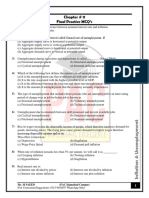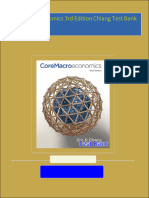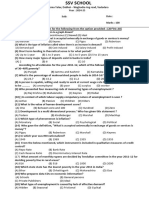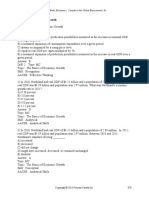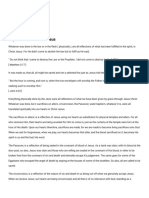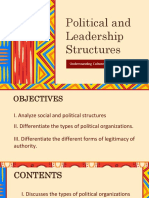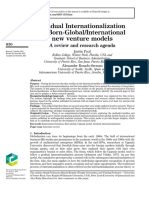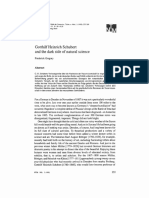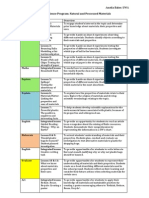Development Studies 1150 Revision Quiz Q
Development Studies 1150 Revision Quiz Q
Uploaded by
ngungiladCopyright:
Available Formats
Development Studies 1150 Revision Quiz Q
Development Studies 1150 Revision Quiz Q
Uploaded by
ngungiladOriginal Title
Copyright
Available Formats
Share this document
Did you find this document useful?
Is this content inappropriate?
Copyright:
Available Formats
Development Studies 1150 Revision Quiz Q
Development Studies 1150 Revision Quiz Q
Uploaded by
ngungiladCopyright:
Available Formats
lOMoARcPSD|40188792
Development Studies 1150 Revision QUIZ Q
Development Studies (University of Zambia)
Scan to open on Studocu
Studocu is not sponsored or endorsed by any college or university
Downloaded by david ngungila (ngungilad@gmail.com)
lOMoARcPSD|40188792
THE UNIVERSITY OF ZAMBIA
SCHOOL OF HUMANITIES AND SOCIAL SCIENCES
DEPARTMENT OF DEVELOPMENT STUDIES
DEV 1150 REVISION TEST 1
INSTRUCTIONS: READ THE INSTRUCTIONS ON EACH SECTION CAREFULLY
DATE: FRIDAY 28/02/2014 DURATION: 45 MINUTES (17HRS- 17:45HRS)
SECTION A: OBJECTIVE. Circle the correct answer. 2 marks for a correct answer, -1 mark for a
wrong answer and zero (0) for a ‘not sure’ response.
1. Gini-coefficient measures
(a). equality levels (b). Income Discrepancy (c).Inequality levels (d). Not sure
2. Micheal Todaro defines development as a multidimensional process involving changes in National
Institutions, Social Structures, Popular Attitudes as well as an acceleration in economic growth,
reduction in inequality and eradication of poverty.
(a). True (b) False (c) Not sure
3. Gross National Product (GNP) and Gross Domestic Product (GDP) are used interchangeably to
mean the same.
(a). True (b). False (c). Not sure
4. GDP, GNP and Human Development Index (HDI) are all economic measures that measure the
wellbeing of people in a country.
(a). True (b). False (c). Not sure
5. The difference between capital inflows and outflows in an economy is
(a). Net Income per Capita (b). Net Factor Income (c) National Factor Income Index (c). Not Sure
6. But for inflation discounts, real GDP and nominal GDP would be the same
(a) True (b). False (c) Not sure
7. The major variables of HDI are literacy rates, life expectancy, income per capita and inequality
rates
(a) True (b). False (c) Not sure
8. W.W. Rostow also sees development as a nonlinear paradigm (a). True (b) False (c) Not sure
Page 1 of 9
Downloaded by david ngungila (ngungilad@gmail.com)
lOMoARcPSD|40188792
9. Economic Growth precedes economic development (a) True (b) False (c) Not sure
10. The second stage of development according to Marxism is capitalism (a) True (b) False (c) Not
sure
SECTION B: SHORT ANSWERS ONLY
11. List the five (5) stages of development according to W.W. Rostow. (5 marks)
12. Mention any four (4) criticisms of modernization theory (4marks)
13. What is the difference between chronic poverty and acute poverty? (2 marks)
14. What is food security? Mention the four (4) levels of food security. (5 marks)
15. Name the two renowned proponents of HDI. (2 marks)
16. Outline four (4) key characteristics of emerging markets (4 marks)
17. What are Nonviable National Economies (NNEs)? (2 marks)
18. Differentiate economic development from economic growth (2 marks)
19. Briefly define the following terms: (a) Nominal GDP (b) Real GDP (c) Inflation [3 marks]
20. Outline the three (3) core values of development according to Denis Goulet. (3 marks)
21. Define social formation according to Marxism. (2 marks)
22. Name the two (2) major financial lending institutions in the world. (2marks)
23. Briefly state the difference between development and underdevelopment (2 marks)
24. List any two (2) features of pre-conditions for takeoff stage according to W.W. Rostow. (2 marks)
25. Differentiate modernization from westernization. (2marks)
END OF WARM UP TEST
Prepared by: J. Nchungo
MARKING KEY
SECTION A
1 C 2 B 3 B 4 B 5 B
6 A 7 B 8 B 9 A 10 B
Page 2 of 9
Downloaded by david ngungila (ngungilad@gmail.com)
lOMoARcPSD|40188792
THE UNIVERSITY OF ZAMBIA
SCHOOL OF HUMANITIES AND SOCIAL SCIENCES
DEPARTMENT OF DEVELOPMENT STUDIES
DEV 1150 REVISION TEST 2
DATE: TUESDAY 11TH MARCH, 2014 DURATION: 30 MINUTES (17HRS-17:30)
INSTRUCTIONS: Circle the correct answer. 2 marks for a correct answer, -1 mark for a wrong
answer and zero (0) for a ‘not sure’ response.
1. The three (3) core values of development according to Denis Goulet are Life Subsistence, Self
Esteem and Freedom of Choice
(a). True (b) False (c) Not sure
2. China has adopted market segmentation in its approach of development
(a) True (b) False
3. The application of science and technology in development is not a key component of
modernization theory
(a) True (b) False (c) Not sure
4. The United Nations Development Programme (UNDP) is the one that came up with HDI
(a) True (b) False (c) Not sure (2 marks)
5. A negative Net Factor Income comes when you have more exports than imports in an
economy (a) True (b) False (c) Not sure (2 marks)
6. Gross National Product (GNP) is not an example of Net Factor Income
(a) True (b) False (c) Not sure (2 marks)
7. Dividing GDP with the current population will result in GDP per capita
(a) True (b) False (c) Not sure
8. To assess the economic performance of Zambian nationals we use Gross Domestic Product
(GDP) as opposed to Gross National Product (GNP) (a) True (b) False (c) Not sure
9. Modes of production limited to pre-Newtonian science according to W.W. Rostow is what
Marxism referred to as Primitive communism
(a) True (b) False (c) Not sure
10. The take off stage according to W.W. Rostow is characterized by the re-investments of
profits and the manufacturing of simple semi-durable machines
(a) True (b) False (c) Not sure
11. Economic development precedes Economic Growth
Page 3 of 9
Downloaded by david ngungila (ngungilad@gmail.com)
lOMoARcPSD|40188792
(a) True (b) False (c) Not sure
12. The following do not characterize Non-viable National Economies (NNEs): periodic increase
in prices of primary commodities, dependence on donor funding, dependency on money
laundering, dependency on rescue packages from the IMF and World Bank
(a) True (b) False (c) Not sure
13. W.W. Rostow describes development as a linear paradigm
(a). True (b) False (c) Not sure
14. Using Gini-coefficient, a reading of 0.78 indicates low inequality levels
(a). True (b) False (c)Not sure
15. Generally, GDP can either be nominal, ordinal, or real
(a). True (b) False (c) Not sure
16. Comparative Advantage is a concept that makes Zambia trade in copper and Malawi in tea
(a). True (b) False (c) Not sure
17. A free market economy favours capitalism
(a). True (b) False (c)Not sure
18. Economic growth is usually expressed in a nominal figure
(a). True (b) False (c)Not sure
19. Dependency Theory can help explain why we keep exporting copper in Zambia.
(a). True (b) False (c) Not sure
20. The major variables of HDI are literacy rates, life expectancy, income per capita and
inequality rates
(a) True (b). False (c) Not sure
END OF REVISION TEST
Prepared by: J. Nchungo
MARKING KEY
1 B 2 A 3 B 4 B 5 B
6 A 7 A 8 B 9 A 10 A
11 B 12 B 13 A 14 B 15 B
16 A 17 A 18 A 19 A 20 B
Page 4 of 9
Downloaded by david ngungila (ngungilad@gmail.com)
lOMoARcPSD|40188792
THE UNIVERSITY OF ZAMBIA
SCHOOL OF HUMANITIES AND SOCIAL SCIENCES
DEPARTMENT OF DEVELOPMENT STUDIES
DEV 1150 REVISION TEST 3
DATE: FRIDAY 20TH JUNE, 2014 DURATION: 30 MINUTES (17HRS-17:30)
INSTRUCTIONS: Circle the correct answer. 2 marks for a correct answer, -1 mark for a
wrong answer and zero (0) for a ‘not sure’ response.
1. Balance of payments is the summation of the amount paid by a national government
to other countries and the amount it receives from them (a). True (b) False (c) Not
sure
2. In development, the state and government are used interchangeably to mean the same
(a) True (b) False (c) Not sure
3. Biodiversity loss is not a major global environmental issue (a) True (b) False (c) Not
sure
4. Government is flexible while the state is rigid (a) True (b) False (c) Not sure
5. A Social entrepreneur is an innovator who focuses on creating products and services
that solve social needs and problems. (a) True (b) False (c) Not sure
6. Scalable Startup Entrepreneurship and Small Business Entrepreneurship are the same
(a) True (b) False (c) Not sure
7. Market speculation is not always critical in any form of investment (a) True (b) False
(c) Not sure
8. Chambers sees NGOs as capacity builders (a) True (b) False (c) Not sure
9. Portfolio investment is long term investment (a) True (b) False (c) Not sure
10. Income per capita cannot be used to determine foreign investment (a) True (b) False
(c) Not sure
11. All entrepreneurs are investors but not all investors are entrepreneurs (a) True (b)
False (c) Not sure
12. Depletion of the ozone layer is caused by high concentration of oxygen molecule
(O3). (a) True (b) False (c) Not sure
13. Time factor is a critical component of any investment (a) True (b) False (c) Not sure
Page 5 of 9
Downloaded by david ngungila (ngungilad@gmail.com)
lOMoARcPSD|40188792
14. In a neo-patrimonial regime, the middle income class is more likely to emerge
because resources are allocated to all sectors of the economy (a) True (b) False (c)
Not sure
15. MNCs can only survive in a closed economy (a) True (b) False (c) Not sure
16. Large Company Entrepreneurs mainly create formal jobs because they are non-
capitalists (a) True (b) False (c) Not sure
17. The government partnering with an NGO will still characterize that NGO as
autonomous and value-driven (a) True (b) False (c) Not sure
18. International trade has little or no say on technological transfer (a) True (b) False (c)
Not sure
19. The major beneficiaries of international trade are importers (a) True (b) False (c) Not
sure
20. Ozone is both a natural and human-made greenhouse gas. (a) True (b) False (c) Not
sure
END OF WARM UP TEST
Prepared by: J. Nchungo
MARKING KEY
1 B 2 B 3 B 4 A 5 A
6 B 7 B 8 A 9 B 10 B
11 A 12 B 13 A 14 B 15 B
16 B 17 B 18 B 19 B 20 A
Page 6 of 9
Downloaded by david ngungila (ngungilad@gmail.com)
lOMoARcPSD|40188792
THE UNIVERSITY OF ZAMBIA
DEPARTMENT OF DEVELOPMENT STUDIES
DEV 1150 TEST 1- MAKE UP
DATE: THURSDAY 3RD APRIL, 2014 DURATION: 20 MINUTES
INSTRUCTIONS: Circle the correct answer. 2 marks for a correct answer, -1 mark for a wrong
answer and zero (0) for non-response.
1. GDP per capita is an accurate measure of personal income (a). True (b) False
2. Simon Kuznets is associated with GDP (a). True (b) False
3. GDP allocate production based on ownership (a). True (b) False
4. Gini-index of 100% indicates maximum equality (a). True (b) False
5. The state of undevelopment is rampant in the early stages of social formation (a). True (b)
False
6. Market segmentation can only be done using a geographical method (a). True (b) False
7. In modernization theory, causes of underdevelopment are neither internal nor external (a).
True (b) False
8. Improved consumption levels in an economy is not a sign of economic development (a). True
(b) False
9. Amartya Sen, Malbub Al Hag and the UNDP composed HDI (a). True (b) False
10. According to Marxism, there is a tradeoff to modernity due to capitalism (a) True (b) False
11. The implied critique of modernization theory is that, the age of high mass consumption can
only be reached by countries in the North (a) True (b) False
12. Rivero does not see an economy to be full of technocrats (a) True (b) False
13. There is focus on semi-durable commodities at the age of high mass consumption (a) True
(b) False
14. Dual sector model does not explain the coexistence of traditional stage and take-off stage in
LDCs (a) True (b) False
15. The state rarely disappears in a communism stage according to Marxism (a) True (b) False
16. A negative balance of payments comes when you have more imports than exports in an
economy (a) True (b) False
17. The Malawian economy is rarely associated with NNEs due to its extensive exports (a) True
(b) False
18. The impasse of development is not the failure of development efforts a) True (b) False
19. The economic ties between Zambia and China can be explained by the Singer-Prebish
Hypothesis (a) True (b) False
20. Economic growth and economic development are mutually exclusive (a) True (b) False
END OF TEST
Page 7 of 9
Downloaded by david ngungila (ngungilad@gmail.com)
lOMoARcPSD|40188792
Set by: Josephat Nchungo
MARKING KEY
1 B 2 A 3 B 4 B 5 A
6 B 7 B 8 B 9 B 10 A
11 A 12 B 13 B 14 B 15 B
16 A 17 B 18 B 19 A 20 B
THE UNIVERSITY OF ZAMBIA
SCHOOL OF HUMANITIES AND SOCIAL SCIENCES
DEPARTMENT OF DEVELOPMENT STUDIES
DEV 1150 OBJECTIVE TEST 2- MAKE UP
DATE: TUESDAY 24TH JUNE, 2014 DURATION: 20 MINUTES
INSTRUCTIONS: Circle the correct answer. 2 marks for a correct answer, -1 mark for a
wrong answer and zero (0) for non-response.
1. The Kyōto Protocol is not one of the measures to reduce production of Green House
Gases. A). True B). False
2. One critical feature of an entrepreneur is the ability to think. A). True B). False
3. Adam Smith is renowned for coining the concept of International Trade A). True B).
False
4. According to David Ricardo, wages are determined by the price of food, which is
determined by the cost of production, itself determined by the amount of labor
required to produce the food A.)True B). False
5. Comparative advantage and absolute advantage do not apply in developed countries
A). True B). False
6. Multinational Corporations (MNCs) and Transnational Corporations (TNCs) are the
same A). True B). False
7. Greenfield investment is a form of Foreign Investment. A). True B). False
8. Foreign Investment and Foreign Direct Investment are the same. A). True B). False
9. About half of the 600 largest MNCs originate from the United States of America A).
True B). False
10. Zambia has some of the MNCs A). True B). False
11. The IMF and World Bank categorizes countries based on their attraction of FDI. A).
True B). False
12. Terms of Trade is not a key determinant of winners and losers in International Trade
A). True B). False
13. Capital accumulation precedes Capital formation in any investment A). True B). False
Page 8 of 9
Downloaded by david ngungila (ngungilad@gmail.com)
lOMoARcPSD|40188792
14. In investments, economies of scale are the driving force behind all mass production.
A). True B). False
15. In a state, Nationality and citizenship are the same A). True B). False
16. Economies of Scale cause the average cost of production to increase as output
decreases. A). True B). False
17. The state has little or no say in a laissez-faire economy. A). True B). False
18. The law of supply and demand revolves around International Trade A). True B). False
19. CFCs are not the only green house gases A). True B). False
20. One critical feature of a neo-patrimonial regime is decentralization A). True B). False
END OF TEST
Set by: Josephat Nchungo
MARKING KEY
1 B 2 B 3 A 4 A 5 B
6 B 7 A 8 B 9 A 10 A
11 B 12 B 13 B 14 A 15 B
16 B 17 A 18 A 19 A 20 B
Page 9 of 9
Downloaded by david ngungila (ngungilad@gmail.com)
You might also like
- Iso 24512 2007Document15 pagesIso 24512 2007Abdelwahab AliNo ratings yet
- Final Exam - 2019 SpecialDocument12 pagesFinal Exam - 2019 SpecialLiz zzzNo ratings yet
- Development Studies 1150 Revision Quiz QDocument9 pagesDevelopment Studies 1150 Revision Quiz QTrần NhiNo ratings yet
- 2020 ECON110A Midterm 1Document13 pages2020 ECON110A Midterm 1sybiltan123No ratings yet
- 2019 Fall FinalsDocument12 pages2019 Fall FinalsmeganyaptanNo ratings yet
- Questions - Homework - 10th - Social Studies - 2021-11-26T13 - 03Document6 pagesQuestions - Homework - 10th - Social Studies - 2021-11-26T13 - 03Nisha SinghNo ratings yet
- s15 Test1Document6 pagess15 Test1Jorge HirsNo ratings yet
- Mains mock test -6 discussionDocument92 pagesMains mock test -6 discussionnamangupta0012No ratings yet
- MCQs For Understanding Economic DevelopmentDocument16 pagesMCQs For Understanding Economic Developmentrajini.mvpk3No ratings yet
- Answers - SOC 2022 U2 P1Document9 pagesAnswers - SOC 2022 U2 P1Khaila SimmondNo ratings yet
- Holidays Homework Class-10 S.STDocument10 pagesHolidays Homework Class-10 S.STsnawar150No ratings yet
- ECO FINAL MCQ's (Chapter #11) JAN 2024Document4 pagesECO FINAL MCQ's (Chapter #11) JAN 2024ajwazubair846No ratings yet
- Micro Midterm May 2015ADocument7 pagesMicro Midterm May 2015ATriet TruongNo ratings yet
- Macroeconomics Final ExamDocument9 pagesMacroeconomics Final ExamMahabbat Dzhenbekova0% (1)
- Test DevelopmentDocument9 pagesTest DevelopmentMR BeastNo ratings yet
- Midterm Exam. (ONLINE) Autumn 2021Document9 pagesMidterm Exam. (ONLINE) Autumn 2021Navid Al Faiyaz ProviNo ratings yet
- 5_6224146969049174724Document17 pages5_6224146969049174724Idiotic PhraserNo ratings yet
- QP en Jam2022Document47 pagesQP en Jam2022Hitesh TrivediNo ratings yet
- Periodic Test 2 Eco Class-12Document4 pagesPeriodic Test 2 Eco Class-12amandeep malikNo ratings yet
- EC Geography Grade 11 November 2022 P2 and MemoDocument25 pagesEC Geography Grade 11 November 2022 P2 and Memobeyoncevela0No ratings yet
- Deep Educations STD: 12 Economics: CHAPTER - 2 Indicators of Growth and DevelopmentDocument26 pagesDeep Educations STD: 12 Economics: CHAPTER - 2 Indicators of Growth and DevelopmentTanvi NarangNo ratings yet
- Midterm Macro 1Document5 pagesMidterm Macro 1huong quynhNo ratings yet
- 200 MCQ of Managerial Economics For Commerce, Mamangement and Economics Downlaod For FreeDocument56 pages200 MCQ of Managerial Economics For Commerce, Mamangement and Economics Downlaod For FreeDivya JaiswalNo ratings yet
- Indian Economy Bit BankDocument25 pagesIndian Economy Bit BanksureshNo ratings yet
- ECONOMICSDocument6 pagesECONOMICSsomoyeenoch33No ratings yet
- GEOGRAPHY P2 QP GR11 NOV2022 - English FinalDocument17 pagesGEOGRAPHY P2 QP GR11 NOV2022 - English FinaltakadzanijustinmaimelaNo ratings yet
- Question Papers Health and Education DepartmentDocument77 pagesQuestion Papers Health and Education DepartmentDaanish MalikNo ratings yet
- UPPCS Prelims 2015: General Studies Paper IDocument36 pagesUPPCS Prelims 2015: General Studies Paper ISwayam YadavNo ratings yet
- Is408-Mid-Term-Test 1Document6 pagesIs408-Mid-Term-Test 1hakseng lyNo ratings yet
- Class X SST Study Material - 2023-24Document600 pagesClass X SST Study Material - 2023-24Sridevi BNo ratings yet
- 250 MCQ For Ugc-Net Commerce and Economics Download PDF For FreeDocument56 pages250 MCQ For Ugc-Net Commerce and Economics Download PDF For FreeDiwakar Entertainment Dose67% (3)
- Complete Download of CoreMacroeconomics 3rd Edition Chiang Test Bank Full Chapters in PDF DOCXDocument60 pagesComplete Download of CoreMacroeconomics 3rd Edition Chiang Test Bank Full Chapters in PDF DOCXagavnileuven100% (3)
- Eco 12TH Test Paper (1 To 6) - SSVDocument3 pagesEco 12TH Test Paper (1 To 6) - SSVnocknock127No ratings yet
- Samplepractice Exam 12 April 2017 Questions and AnswersDocument17 pagesSamplepractice Exam 12 April 2017 Questions and AnswersMelody YayongNo ratings yet
- SSSIHL Admissions Model Test Paper Doctoral Research EconomicsDocument3 pagesSSSIHL Admissions Model Test Paper Doctoral Research Economicspalitdolla24No ratings yet
- Ad SociologyDocument40 pagesAd Sociologyvigneshwari jNo ratings yet
- ECON303 2023 Final ExamDocument10 pagesECON303 2023 Final ExammadelineroselaneNo ratings yet
- International Relations MCQs - International and Regional Organizations MCQs PDFDocument10 pagesInternational Relations MCQs - International and Regional Organizations MCQs PDFSadia manzoorNo ratings yet
- 112-2 經濟學Lec4 - 240417 - 085852Document82 pages112-2 經濟學Lec4 - 240417 - 085852112205013No ratings yet
- PART-1: MCQ's On Economics For PracticeDocument43 pagesPART-1: MCQ's On Economics For PracticeRakesh KumarNo ratings yet
- MCQ's On EconomicsDocument43 pagesMCQ's On Economicsआई सी एस इंस्टीट्यूटNo ratings yet
- Development & EnvironmentalDocument25 pagesDevelopment & EnvironmentalHarikrishnan HNo ratings yet
- Geography p2 QP Gr11 Nov2022 - English FinalDocument16 pagesGeography p2 QP Gr11 Nov2022 - English Final9vjmb4yqqkNo ratings yet
- Chapter 22 Economic Growth: Parkin/Bade, Economics: Canada in The Global Environment, 8eDocument31 pagesChapter 22 Economic Growth: Parkin/Bade, Economics: Canada in The Global Environment, 8ePranta SahaNo ratings yet
- Chapter 22 Economic Growth: Parkin/Bade, Economics: Canada in The Global Environment, 8eDocument31 pagesChapter 22 Economic Growth: Parkin/Bade, Economics: Canada in The Global Environment, 8ePranta SahaNo ratings yet
- ECONOMIC AND SOCIAL DEVELOPMENT (Questions Only)Document16 pagesECONOMIC AND SOCIAL DEVELOPMENT (Questions Only)RavenNo ratings yet
- Igcse-Economics-Online-Examination (Without Edits)Document9 pagesIgcse-Economics-Online-Examination (Without Edits)Zuhair MahmudNo ratings yet
- JAIIB Genius Week 15 2023Document10 pagesJAIIB Genius Week 15 2023Anand MekalaNo ratings yet
- Macroeconomics Midterm 2013Document19 pagesMacroeconomics Midterm 2013Daniel Welch100% (2)
- x Social Science Excellence Series,Ziet,Bbsr.docx (1)Document667 pagesx Social Science Excellence Series,Ziet,Bbsr.docx (1)YUVI GAMERNo ratings yet
- Econ - Practice Exam 2Document8 pagesEcon - Practice Exam 2John DoeNo ratings yet
- Rbi Grade B (Depr) - Test-2Document17 pagesRbi Grade B (Depr) - Test-2avinash ranjanNo ratings yet
- Type of Task: Controlled Test 2 (2023)Document8 pagesType of Task: Controlled Test 2 (2023)Anathiey Certified Jnr.No ratings yet
- Best Higher Secondary School Economics Class Test Marks 50 Time 45 MinDocument4 pagesBest Higher Secondary School Economics Class Test Marks 50 Time 45 Minapi-232747878No ratings yet
- 30 Mock Test Paper-1Document653 pages30 Mock Test Paper-1amberatalNo ratings yet
- 2020 Nusgc Individual Component QuestionsDocument15 pages2020 Nusgc Individual Component QuestionsTerra JurnalNo ratings yet
- Class X SST Study Material - 2023-24Document571 pagesClass X SST Study Material - 2023-24umaunni12No ratings yet
- Most Imp 499 MCQs On Economics.Document43 pagesMost Imp 499 MCQs On Economics.Rahul Kumar DabotraNo ratings yet
- EC101 Autumn 2023 Quiz 2Document3 pagesEC101 Autumn 2023 Quiz 2countdownbegins86No ratings yet
- Limitations of FaithDocument13 pagesLimitations of FaithngungiladNo ratings yet
- Baptism in The Name JesusDocument7 pagesBaptism in The Name JesusngungiladNo ratings yet
- Kba Top ScorersDocument1 pageKba Top ScorersngungiladNo ratings yet
- Ds Past Papers 2Document12 pagesDs Past Papers 2ngungiladNo ratings yet
- Violence Against Dalit WomenDocument155 pagesViolence Against Dalit WomenSharon TiggaNo ratings yet
- ■ Subject / Title: ★ 출처 - couldn't be found on the InternetDocument12 pages■ Subject / Title: ★ 출처 - couldn't be found on the InternetDkchksoonwNo ratings yet
- Leadership and Political Structure PresentationDocument35 pagesLeadership and Political Structure PresentationFhia Angelika IntongNo ratings yet
- Digital PLL Cicc Tutorial PerrottDocument118 pagesDigital PLL Cicc Tutorial PerrottSwethaVellankiNo ratings yet
- The Rewards and Challenges of Human Resources ManagementDocument30 pagesThe Rewards and Challenges of Human Resources ManagementCassandra LimNo ratings yet
- Gradual Internationalization Vs Born-Global/International New Venture ModelsDocument29 pagesGradual Internationalization Vs Born-Global/International New Venture ModelsGDKR ReddyNo ratings yet
- Planning of Green HospitalsDocument24 pagesPlanning of Green HospitalsAwadhesh Chandra Verma67% (3)
- Business. (New York: Mcgraw-Hill Book Company, 1976), P. 150Document9 pagesBusiness. (New York: Mcgraw-Hill Book Company, 1976), P. 150Elsa OsNo ratings yet
- REM.S - para Valvula Hidraulica ProporcionalDocument2 pagesREM.S - para Valvula Hidraulica ProporcionalvamelelectronicaNo ratings yet
- TS For Pipe-Duct DismantlingDocument10 pagesTS For Pipe-Duct DismantlingAmitava SilNo ratings yet
- Chapter IV Planning RiteshDocument15 pagesChapter IV Planning RiteshKaustav DasNo ratings yet
- Working On Extreme Hot Weather ConditionDocument16 pagesWorking On Extreme Hot Weather Conditionroland mago100% (1)
- SPEAKING b1Document13 pagesSPEAKING b116YB- YKV Lớp100% (1)
- 80 M LoopDocument6 pages80 M LoopTJBNo ratings yet
- Leica Geosystems GS20: User ManualDocument44 pagesLeica Geosystems GS20: User ManualworgmeNo ratings yet
- Proper Use of ToolsDocument14 pagesProper Use of ToolsSharon TagleNo ratings yet
- App GuideDocument2 pagesApp GuideKaiser IqbalNo ratings yet
- May 2010 EE Board Exam ESAS 6Document2 pagesMay 2010 EE Board Exam ESAS 6Master JaguarNo ratings yet
- G.H. Schubert and The Dark Side of Natural ScienceDocument15 pagesG.H. Schubert and The Dark Side of Natural ScienceJuan EmilioNo ratings yet
- Written Work 1-EnglishDocument2 pagesWritten Work 1-EnglishNathan LlanesNo ratings yet
- IoT AIDocument20 pagesIoT AIJoana Mariel AmaroNo ratings yet
- Year 4 Science Program Overview - MaterialsDocument1 pageYear 4 Science Program Overview - Materialsameliabaker13No ratings yet
- An Analysis of Figurative Language Used in BrunoDocument7 pagesAn Analysis of Figurative Language Used in BrunoogikNo ratings yet
- YOYIK HL-6-50-15 LVDT DatasheetDocument1 pageYOYIK HL-6-50-15 LVDT DatasheetTitoNo ratings yet
- ScalaDocument505 pagesScalagaloise100% (8)
- JSE Building GuidelinesDocument13 pagesJSE Building GuidelinesArtemisNo ratings yet
- Audi A4 No. 303 / 1: 3.0 L - Injection Engine (162 KW - Motronic - 6 Cylinder) Engine Code AVKDocument20 pagesAudi A4 No. 303 / 1: 3.0 L - Injection Engine (162 KW - Motronic - 6 Cylinder) Engine Code AVKDaniel BuenoNo ratings yet
- Rubaflex Klemprofielen AfbeeldingenDocument16 pagesRubaflex Klemprofielen AfbeeldingeninfoNo ratings yet
- Eigen Value Eigen Vector and DiagonalizationDocument19 pagesEigen Value Eigen Vector and Diagonalizationvolatility75sNo ratings yet











